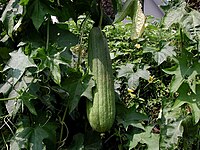
Photo from wikipedia
A new bioadsorbent from Luffa cylindrica and cross-linked chitosan was proposed in the present study. Luffa was used as a natural support medium for chitosan crosslinked with glutaraldehyde (LCsG) and… Click to show full abstract
A new bioadsorbent from Luffa cylindrica and cross-linked chitosan was proposed in the present study. Luffa was used as a natural support medium for chitosan crosslinked with glutaraldehyde (LCsG) and epichlorohydrin (LCsE). Biosponges were applied to remove Allura red from aqueous solutions. LCsG and LCsE were produced using different concentrations of chitosan (1%, 3% and 5% (m v-1)) and crosslinking agents (0.5%, 1.0% and 1.5% (v v-1)). Based on the FT-IR spectra, functional groups characteristic of chitosan crosslinked with glutaraldehyde and epichlorohydrin confirmed the crosslinking. In addition, the biosorbent revealed highly efficient functional groups and morphology with irregularities favorable for adsorption. It was found that the increase in the percentage of glutaraldehyde and epichlorohydrin increased the sample's swelling degree, and the degree of cross-linking was greater than 80% for all LCsG. The results regarding the degree of swelling and degree of crosslinking corroborated with the evaluation of the biosponge's adsorptive potential. The Sips model predicted the equilibrium isotherms, with a maximum adsorption capacity of 89.05 mg g-1 for LCsG and 60.91 mg g-1 for LCsE. The new procedure was successful. Luffa was excellent support for chitosan, resulting in an attractive, low-cost bioadsorbent, preventing renewable sources.
Journal Title: International journal of biological macromolecules
Year Published: 2021
Link to full text (if available)
Share on Social Media: Sign Up to like & get
recommendations!